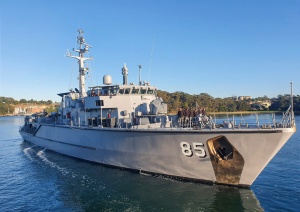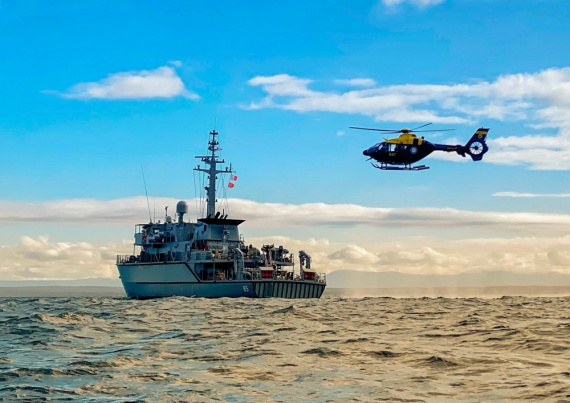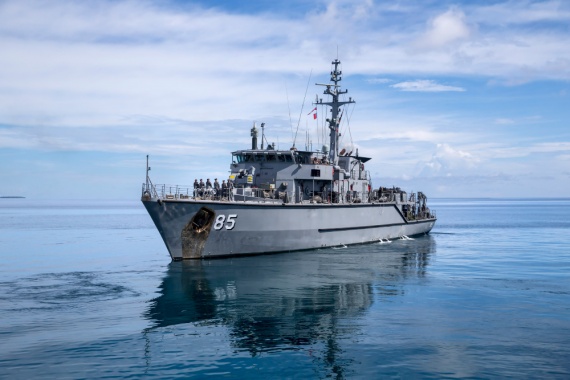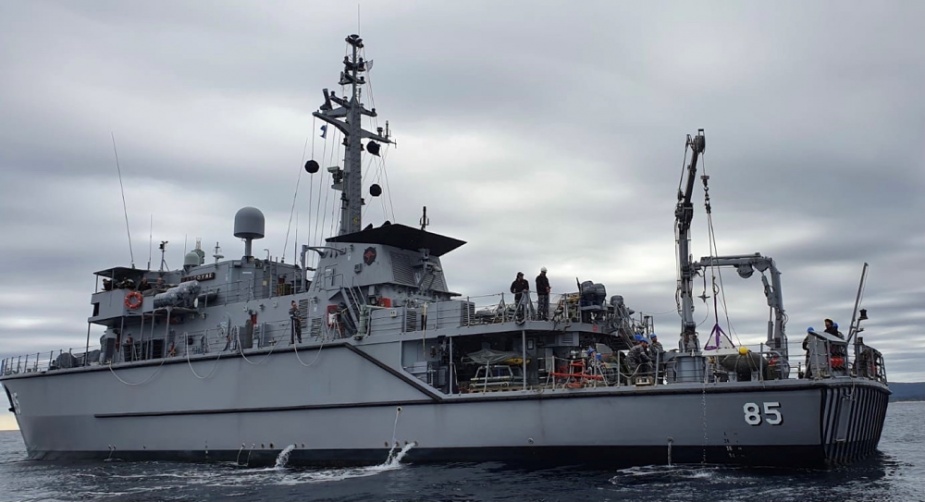HMAS Gascoyne (II)
| Class |
Huon Class |
|---|---|
| Type | |
| Role | Mine Warfare |
| Pennant |
M85 |
| International Callsign |
VLTF |
| Motto |
Return to the Sea |
| Home Port | |
| Builder |
ADI Newcastle |
| Launched |
11 March 2000 |
| Launched by |
Commissioning Guest of Honour: Ms Victoria Peel, daughter of the late CAPT John Peel, DSO, RAN, Commanding Officer of HMAS Gascoyne (I) |
| Commissioned |
2 June 2001 |
| Decommissioned |
5 December 2024 |
| Dimensions & Displacement | |
| Displacement | 732 tonnes |
| Length | 52.5 metres |
| Beam | 9.9 metres |
| Draught | 3 metres |
| Performance | |
| Speed | 14 knots |
| Range | 1,600 nautical miles |
| Complement | |
| Crew | 46 |
| Propulsion | |
| Machinery |
|
| Armament | |
| Guns | 1 x MSI DS 30B 30mm |
| Physical Countermeasures |
|
| Electronic Countermeasures | AWADI Prism |
| Radars | Kelvin Hughes 1007 |
| Sonars | GEC-Marconi Type 2093 |
| Combat Data Systems | GEC-Marconi Nautis 2M |
| Weapon Control Systems | Radamec 1400N optronic surveillance system |
| Awards | |
| Inherited Battle Honours | |
| Resources | |
| News Articles | |
| Image Gallery | |
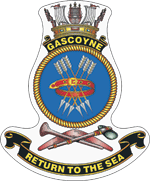
HMAS Gascoyne (II) was the fourth of the six Huon Class Minehunters (MHC). The ship was launched on 11 March 2000 and was based in Sydney at HMAS Waterhen. A large minehunter by world standards, the 720 tonne, 52.5 metre MHC was propelled by a V8 diesel engine driving a controllable pitch propeller in transit, and three retractable thrusters while minehunting. The Huon-class features a unique hull design, shock resistance and an inherently low magnetic signature, allowing the ships to operate in hostile mine environments. Each hull was designed with no ribs, frames or stiffeners to avoid local stress points that could separate under shock conditions.
Gascoyne was the second RAN ship to carry the name. HMAS Gascoyne (I) was Australia's first River Class Anti-Submarine Frigate, and served with distinction during the Second World War. In October 1944, while surveying for the US landings at Leyte Gulf, Gascoyne (I) experienced 39 air attacks and saw 30 Japanese aircraft destroyed. In July 1945, she provided bombardment support for the Australian troop landings in the Balikpapan area of Borneo.
Origins of the Gascoyne name
The Gascoyne is an area of undefined boundaries in the north west of Western Australia. The area takes its name from the Gascoyne River, Western Australia's longest river (820 km) that lies approximately 800 km north of Perth. George Grey named it in 1839 “after my friend, CAPT J. Gascoyne”. The original HMAS Gascoyne was named after this river.
The Gascoyne Region is about twice the size of Tasmania and incorporates some key coastal geographic features including: Ningaloo Reef and Marine Park, Coral Bay, Cape Range National Park and the Shark Bay World Heritage Area. The region also contains Mt Augustus - the world's largest monocline.
While the region’s population is only 9700, it still attracts a number of tourists and mid-term visitors, which provide a significant input to the region’s economic base. Fishing, mining, horticulture and pastoralism also contribute to the Gascoyne region’s economy.
Ship history
HMAS Gascoyne (II) was built by ADI Newcastle, and commissioned into the Royal Australian Navy on 2 June 2001 at HMAS Waterhen in Sydney Harbour. Among the guests present at the ceremony were HMAS Gascoyne (I) veterans; the Commissioning Guest of Honour, Ms Victoria Peel, daughter of the late CAPT John Peel, DSO, Commanding Officer of HMAS Gascoyne (I); the Minister for Defence, the Hon Mr Peter Reith, MP; the Chief of Navy, VADM David Shackleton; and Maritime Commander Australia, RADM Geoffrey Smith.
After commissioning, Gascoyne completed sea trials and unit readiness evaluations, and commenced mine countermeasure operations as part of Exercise KAKADU 2001, alongside ships of the Singaporean and New Zealand navies. Later in the year, the ship carried out deep sonar trials in Spencer Gulf, South Australia. In September 2002, after a transit from Waterhen via port visits at Cairns, Darwin and Broome, Gascoyne sailed into Exmouth, Western Australia, a port in the Gascoyne region after which the ship was named. The ship’s company exercised the right of Freedom of Entry with a march through Exmouth, accompanied by the WA Naval Band. The return journey to Waterhen saw the ship call at Fremantle and Port Adelaide, thus circumnavigating the continent.
As a minehunter, Gascoyne’s tasks included carrying out route surveys of ports, deploying clearance divers, and deploying electrically powered mine disposal vehicles. Gascoyne was force assigned to Operation ESTES in 2001, carrying out regular surface patrols of Bass Strait. In 2004, the ship deployed on Operation ANODE to provide assistance to the Solomon Islands. In 2009, the ship deployed again to the Solomon Islands, this time on Operation RENDER SAFE, safely disposing of sixteen pieces of remnant underwater unexploded ordnance from the Second World War. Gascoyne was a regular participant in Exercise DUGONG, a multi-national mine countermeasure exercise to ensure Navy’s effectiveness and interoperability in mine warfare.
HMAS Gascoyne deployed on border protection duties on Operation CRANBERRY (2006), and on Operation RESOLUTE in 2006, 2007, 2014, 2019, and 2024. This included surveillance patrols, boarding of suspected irregular entry vessels, and investigation of suspected illegal fishing activity in the Australian exclusive economic zone.
On a deployment beginning in September 2021, Gascoyne circumnavigated Australia in 90 days, carrying out route surveys in ports in each mainland state. During this deployment, divers from Gascoyne dived the wrecks of the three Charles F. Adams class guided missile destroyers, HMA Ships Brisbane (II), Perth (II), and Hobart (II), each in the waters of a different state. For the first time in nearly two decades, the ship’s company exercised its Freedom of Entry with a march in Exmouth, in north-western Western Australia.
Gascoyne’s crew took pride in their ship and its effectiveness. Gascoyne was awarded the Rushcutters Shield for excellence in mine countermeasures in 2004, 2014, 2016, 2017, 2020, and 2022, and the Sarawak Shield in 2014 for excellence in all aspects of operations, safety, reliability and training. In 2022, Gascoyne’s crew won the Pakistan Shield for sporting excellence. Members of the ship’s company deployed to flood-affected areas of New South Wales in 2022 on Operation FLOOD ASSIST.
HMAS Gascoyne deployed overseas for the first time in May 2003, visiting ports in Indonesia and Malaysia. During this deployment, in company with sister ship HMAS Norman, Gascoyne conducted the first visit of a Royal Australian Navy vessel to Cambodia since 1996. The ship participated in Exercise FLYING FISH 2003, exercising mine countermeasure operations and mariner skills with units from the member nations of the Five Power Defence Agreement.
In 2018, alongside forces from New Caledonia, France, New Zealand, Vanuatu, and Tonga, Gascoyne participated in Exercise CROIX DU SUD in New Caledonia. This exercise involved field training that demonstrated an enduring contribution to humanitarian assistance and disaster relief.
In both 2018 and 2019, Gascoyne took part in exercises with units of the US Navy and the Japanese Maritime Self-Defence Force to increase proficiency in mine countermeasure operations. During the 2019 northeast Asian deployment, in company with HMAS Diamantina, Gascoyne achieved 42°N, the most northerly latitude ever visited by an Australian minehunter, during a port visit to Hakodate, Japan.
HMAS Gascoyne decommissioned on 5 December 2024 after twenty-three years of proud service to the nation. During that time, hundreds of officers and sailors developed a strong affiliation with the ship, heeding the injunction of its motto to return to the sea.
| Comanding Officer | Date |
| Commander Mark D. Hill | June 2001 |
| Lieutenant Commander Jay B. Bannister | March 2002 |
| Lieutenant Commander Dean P. Schopen | June 2003 |
| Lieutenant Commander Brad J. Vizard | February 2005 |
| Commander Pete D.J. Bartlett | September 2006 |
| Lieutenant Commander Max H.O. Muller, CSM | December 2006 |
| Lieutenant Commander Michael A. Parker (Crew Three) | September 2008 |
| Lieutenant Commander Andrew M.R. Stevens (Crew Three) | June 2010 |
| Lieutenant Commander Damien L. Scully-O’Shea (Crew Five) | July 2010 |
| Lieutenant Commander Charles B. Fennell (Crew One) | December 2010 |
| Lieutenant Commander Aaron L. Cox | December 2012 |
| Lieutenant Commander Alan Parton | January 2015 |
| Lieutenant Commander Richard E. Brickacek, DSM | December 2016 |
| Lieutenant Commander Sean A.M. Aitken | December 2018 |
| Lieutenant Commander Geoffrey V. Crane | December 2020 |
| Lieutenant Commander Lachlan J. Browne | December 2022 |

